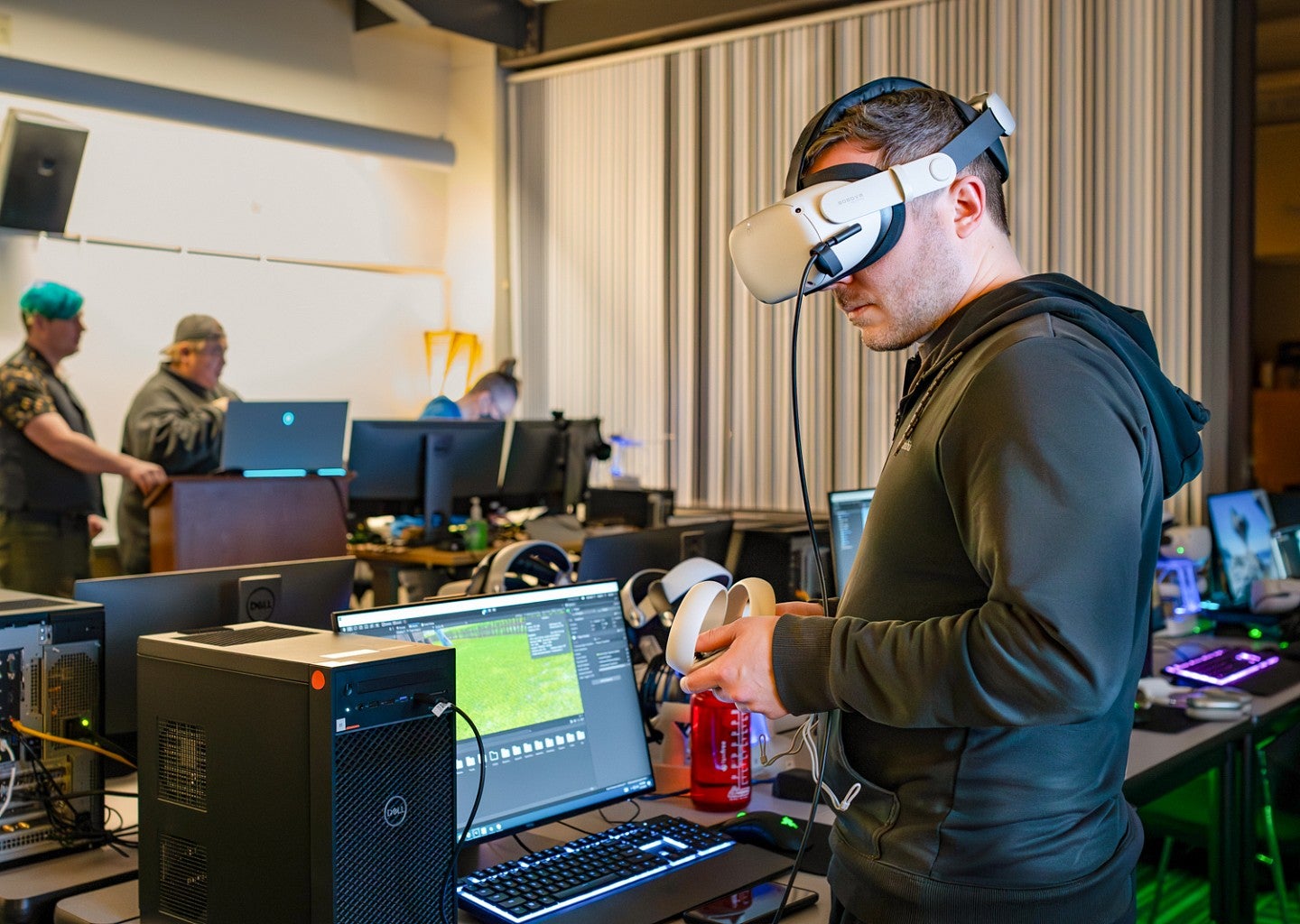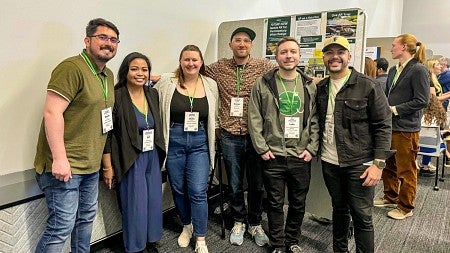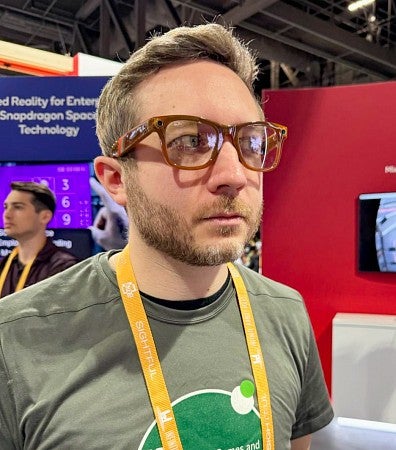Luke Walker, a 2024 dual master’s graduate of the Immersive Media Communication and Strategic Communication master’s programs, suggested improvements to NASA’s video game strategy.

by Ethan Donahue, class of ’26
What can the world’s most prominent and successful space program learn from a UO immersive media communication and strategic communication dual master’s graduate?
Turns out, quite a bit.
As NASA pursues new ways to communicate about its programs and discoveries, immersive technologies like augmented reality (AR), virtual reality (VR), and extended reality (XR) are emerging as a way to help younger generations get involved with the agency and with science in general.
Enter Luke Walker, whose recent internship with NASA highlights the increasing importance of strategic communication and immersive media in science communication.
Walker, a 2024 dual master’s graduate from the UO School of Journalism and Communication’s (SOJC) Immersive Media Communication and Strategic Communication graduate programs, is now preparing to move into the Communication and Media Studies Ph.D. program. His work focuses on how societies and users interact with immersive media.
As a research assistant at UO’s Oregon Reality Lab, he explores prosociality within virtual world design using augmented and virtual reality. In other words, he researches how organizations can promote beneficial behaviors — helping, sharing, caring — by developing immersive stories.

One example that Walker worked on was a project created by Snap AR Scholars. This SOJC student-led creative agency was the brainchild of Danny Pimentel, assistant professor of immersive psychology. Supported by a partnership with Snap Inc., the parent company of Snapchat, the Snap AR Scholars team worked with the nonprofit Hope for Haiti to create an immersive story to educate people about the country and ultimately motivate them to donate.
Walker graduated from Washington State University with a psychology degree in 2018 but chose not to pursue a Ph.D. in psychology. Instead, he began looking into “media psychology” opportunities. He spoke with Donna Davis, the director of the Immersive Media and Strategic Communication Master's programs, during this search, but his plans were interrupted by the COVID pandemic.
When the pandemic subsided, he reconnected with Davis who supported him in applying for the immersive and strategic communication programs. He chose both SOJC master’s programs because of their academic focuses and because they were based in Portland.
Soon after he started, Walker discovered another advantage of the programs: His cohort was composed of other like-minded creatives excited about communicating with immersive media. One of his peers even connected him to a dream internship.
Chasing a dream to work for NASA
Walker had long had a goal to work for NASA and mentioned it to Alec Freudenstein, who was in his immersive media cohort. Freudenstein had a NASA connection and directed Walker to NASA’s internship listings.
“I hadn’t even known about the internships, hadn’t even considered applying until (Freudenstein) mentioned they were recruiting and that he had given my name to his contact,” Walker said.
Walker applied for three internships: an unreal engine internship, a metaverse internship and a communications internship. He was selected for the communications internship, which examined how NASA could use strategic communication and video games to spread information and spark interest in interstellar science.

In August 2024, two months after completing the dual master’s programs, Walker began the five-month virtual internship, where he analyzed NASA’s relationship with gaming and then presented steps the organization could take to expand its presence and increase engagement in science education-based games. Specifically, he was tasked with providing feedback on NASA’s current game collaborations and examining how NASA’s brand guidelines impact its collaborations with video games and digital media.
He realized immediately that his master’s programs had prepared him well for the work.
“It almost felt like I was a consultant. I had more expertise (than they did) in the video game industry, and I have a degree in strategic communication,” Walker said. “It felt more like I was catching my internship team up. NASA is a leader in science communication and has cutting-edge technology within the science community, but they have a just awful video game presence.”
Walker began by poring over research on game studios, platforms, developers and conferences while exploring trends and historical uses of science communication in AR/VR gaming. He interviewed NASA employees who had built games for NASA and talked to curators from the Boston Museum of Science. He also reviewed data on genre preferences, gamer demographics, playtime, developer preferences and platform popularity.
Strict guidelines limited NASA’s audience
Through his research, Walker identified some foundational issues related to NASA’s guidelines. NASA has a strict policy against affiliating with platforms that depict violence or themes of world domination. These policies align with NASA’s educational goals, but they limit partnerships to primarily STEM-educational platforms like 2023 Minecraft Education Artemis Missions. That has kept the agency from reaching the wider gaming community.
Realizing that over 60% — or 114 million — of U.S. gamers are older than 30, Walker concluded that NASA’s outreach strategy needed to be refined, since such a large portion of U.S. gamers wasn’t being marketed to and NASA’s existing games weren’t sparking widespread community engagement.
NASA’s participation in games, such as the Minecraft Artemis Missions, Moonbase Alpha, Exoplanet Excursions and Project Eagle, yielded varying degrees of engagement and responses. Moonbase Alpha, released in 2010, currently has 12,824 reviews, 90% of which are “very positive.” Exoplanet Excursions, 2018, has 22 reviews with 86% being “positive.” Project Eagle, also released in 2018, has 538 reviews with 75% being “positive.” In comparison, popular space-related games like No Man’s Sky or Subnautica both have over 260,000 reviews. 85% of No Man’s Sky reviews are positive and 97% of Subnautica’s reviews are positive. But both games have violent themes, No Man’s Sky is rated Teen or for ages 13+, which prevented them from partnering with NASA, and Subnautica, while rated ESRB or 10+, does have themes of fantasy violence and horror.

Collaborations — or the lack thereof — were also an issue. “NASA doesn’t collaborate much, and the collaborations they have done were pretty bad,” Walker said.
At the end of Walker’s internship, he presented changes he believed would draw a wider audience to NASA.
“The final presentation was a big one. Everyone in NASA was invited,” Walker said. “My mentor (Maureen O’Brien) was reaching out to all the centers and everyone she knew telling them about it. I ended up presenting to about 45 employees. They were like, ‘OK, what do we do next?’”
During that presentation, Walker pushed for NASA to rework its content policy regarding violent themes, even if it was only to include games with action or suspenseful moments. He also recommended refining the language in NASA’s partner intake form and brand guidelines to clarify how and where game developers can collaborate with NASA.
“I suggested some modifications of the partner intake form, which were pushed through,” Walker said. “They seem pretty positive about my suggestions being implemented, which is awesome.”
The final part of the internship requires Walker to present his work at the Oregon NASA Space Grant Consortium at Oregon State University.
As Walker prepares to enter SOJC’s doctoral program and continues his work with the OR Lab and Snap AR Scholars, he wants to explore the relationship between immersive media, science communication and gaming. He plans to focus on bridging the gap between STEM, science education, science communication and immersive media to ensure science-based organizations can effectively connect with large audiences.
Ethan Donahue is a journalism major with a double major in history. He is part of the School of Journalism and Communication’s direct-admit and honors programs. He is also part of the Clark Honors College. He holds an interest in investigative and conflict journalism and is working on a thesis focusing on how journalism, propaganda and the U.S. government interact during conflicts.
